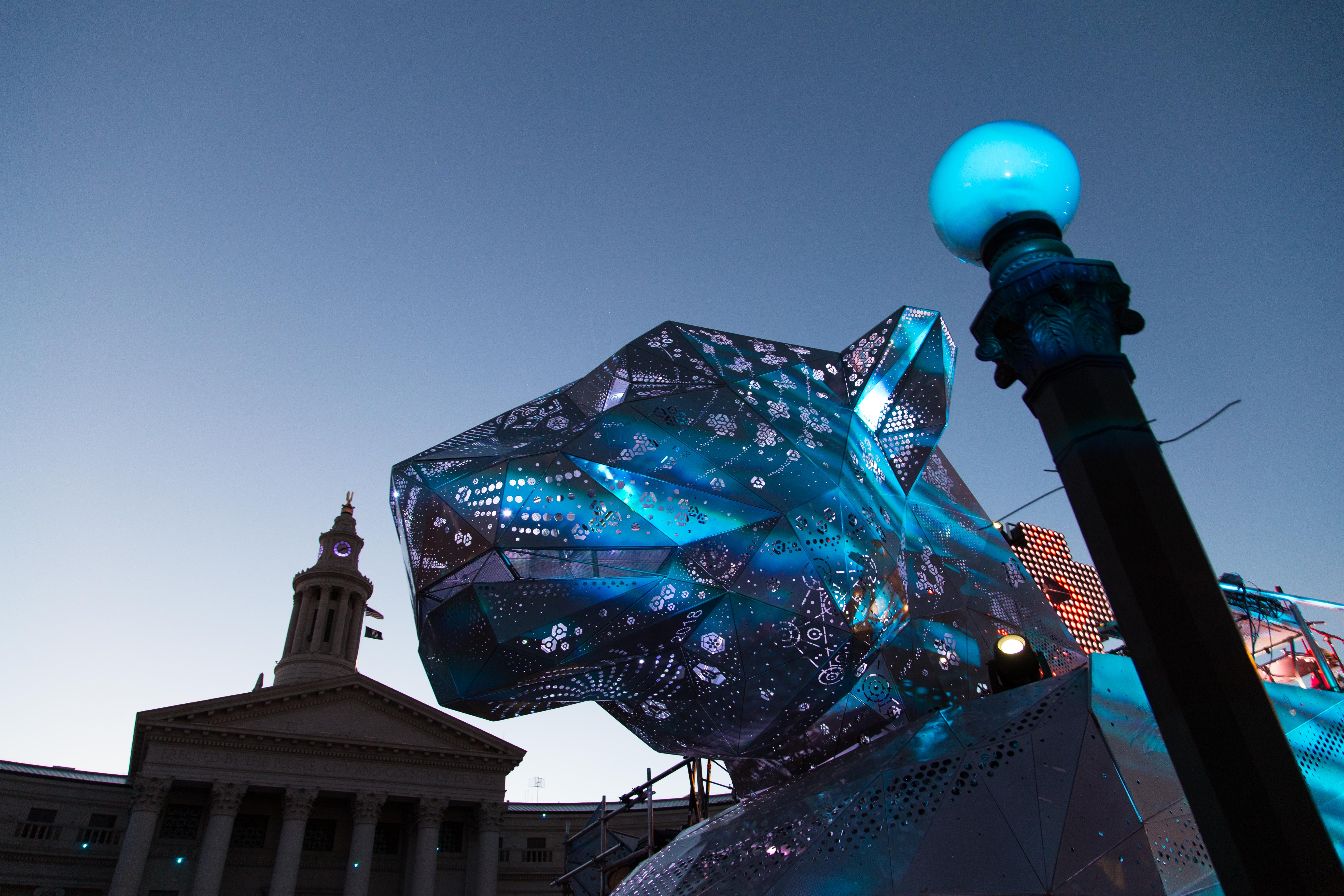In case you missed it on Saturday night, a giant geometric metal jaguar took over Civic Center Park, acting as a stage for a lineup of Latinx musicians during the centerpiece of the Biennial of the Americas festival. Once the sun went down and darkness set in, beautiful projections came to life on the Denver City and County Building, evoking South American motifs and transforming downtown into an urban jungle.

This experience is all part of Jaguara — an art car, concert stage and conservationist movement created by Colombian-based duo Leonardo Vilar and Catalina Pulido of Sonic Design. Originally made for Burning Man last year, this massive art installation is much more than a breathtaking showcase of creativity — it has the potential and energy to inspire action for its cause.
“From the moment this project came to mind, we had a strong feeling that Jaguara could be a very innovative and powerful way to join forces with many great friends from different areas and bring an urgent message from the rainforest to the world,” Vilar and Pulido explained. “It has been interesting, after meeting great people and organizations who have been doing work at many levels to protect nature and jaguars for a long time, that they find our project very inspiring as a good messenger to get more people interested and involved with the work to be done.”
One of the people who has worked on protecting nature for decades — and who helped with Jaguara — is Colombian anthropologist Carlos Castaño-Uribe. He also appeared as a panelist at the Biennial during the clinica “Green with Empathy” due to his time served as the Director of National Parks in Colombia. His wealth of knowledge was passed onto Vilar and Pulido after he and his wife attended Burning Man with them to speak about the “Chiribiquete sacred Shamanic rock-art (22,000 + year old) depicting Jaguars as sacred power animals and jaguar men protecting the balance between man and nature.”
According to Vilar and Pulido, “Carlos has spent the past 35 years doing research on the jaguar across America… one day by accident while coming from Leticia in the Amazon to Bogota, his small plane was deviated by a storm and he ran into the Serranía del Chiribiquete. This area is believed to be the shamanic center of the Amazon Rainforest. It is the place where the oldest rock art from the American continent has been found so far with more than 70,000 drawings found to date. After 32 years of research and work in this area, Carlos led the process in 2018 for the declaration of Chiribiquete by UNESCO as a world heritage site (Cultural and Biological).”
With the influence of Castaño-Uribe and other conservationists behind Jaguara, the project moves beyond an art installation and into the world of activism. But this isn’t the activism that we’ve become familiar with — foreign artists and celebrities trying to bring attention to far-away problems — instead, this is a collaborative effort among people who feel the immediate effects of ecosystem destruction. This is where Jaguara’s full impact is realized.
Throughout the Biennial, conversations about fixing problems kept returning to an idea — we have to empower people to care. With relentless streams of information bombarding us every minute of the day, we tend to come down with news fatigue, where we find it easier to stop caring since there are more problems than we know how to solve. Experiencing the full spectacle of Jaguara, however, has the power to enliven people to react. Rather than inducing fatigue, Jaguara renews hope. With the sounds of the rainforest through bands like Mucho Indio and Systema Solar, vibrant digital projections by Catalina Estrada and Akira Hasegawa and the illuminated jaguar at the center, the audience is transported to a place where they are affected by the plight of an animal and ecosystem in trouble, as if it was their own home. This is the kind of empathy necessary for global climate rehabilitation.
“Jaguara’s mission is to inspire people to come closer to nature, to the rainforest, to the jaguar energy, and create collaborative bridges to restore the balance between man and nature. ‘When the Eagle of the North and the Condor of the South fly together again, the spirit of the land will re-awaken,'” explained Vilar and Pulido. They added, “that is what the Biennial of the Americas is about, uniting leaders, artists, governments, companies, and institutions to find solutions for our continent, together. Also, we see Denver as home to a community leading important changes in the world, people connected to nature. So here we are after letting this opportunity flow into existence.”
The wonder and magic of Jaguara only happened in Denver on one night, but Vilar and Pulido hope to take it on the road to spread their messages. They hope that by doing so, more people will get involved in the protection of the Amazon rainforest and in the support of Indigenous communities from the Amazon — groups whom they believe have things to teach the rest of us, specifically in our lack of connection to “the essential things in life.”
“We really hope the critical moment happening right now at the Amazon Rainforest is the bottom line to get more powerful people, technology and companies involved in the protection of this sacred area. The number of people getting benefits from hurting the land is not big enough if we get together and find new ways to stop this,” the couple explained. “With all technology and current resources available in the world it is unacceptable to think the protection of this ecosystem so critical for the future of life on Earth depends so much on a few Latin American governments.”
—
For more information about Jaguara, visit this website.





